Hey! Happy Saturday! Matt here.
Welcome to the Construction Curiosities newsletter!
This week, we are back in Regulations Land.
In 2025, Vibe Coding is all the rage, but we are going old school and looking at Code Books. (plus a little 2025 AI code flavor)
Summary
This week we will look at:
One Musing: RTFC: Read the F’n Code
One Video: Did the County or Inspector say No?
Contech Corner: UpCodes
One Meme: 1990s Code
RTFC: Read the F’n Code (For Real This Time)
I’ve lost count of how many times someone’s justified a design decision, field change, or last-minute fire caulk fire drill with the words:
“It’s code.”
It’s the construction version of “because I said so.”
And half the time, it’s just someone trying to sound like they know what they’re talking about.
Did you know:
Over 93% of U.S. communities use building codes based on the ICC’s I-Codes
(source: ICC Global Report, 2023)
So if you’re in this industry, there’s a damn good chance you’re expected to know what’s in these books or at least know where and how to find the answer.
Let’s fix the knowledge gap.
What Is the Building Code, anyway?
There’s no single national building code. The ICC (International Code Council) publishes model codes, and local jurisdictions adopt them with their own locally approved edits.
Which means:
Code is not universal. “IBC 2021” in Houston isn’t the same as “IBC 2021” in Chicago. Same model code, but possibly wildly different enforcement. Some AHJs modify like crazy. Others leave it intact but interpret things their own way.
Code books are not instructions. They tell you the minimum required. Not how to do it. That’s where Commentary books come in — and those are the cheat codes most professionals never crack open.
“It’s not in the code” ≠ “You don’t have to do it.” Code sets the floor, not the ceiling. There are best practices, project specifications, manufacturer installation instructions, etc. that might apply even if the literal code doesn’t mention it.
Inspectors are not your enemy. But they’re not your designer either. They don’t tell you how to fix it. They just tell you when it doesn’t meet code. You’re supposed to know the code well enough to know how to resolve it.
What the Hell Do All These I-Codes Stand For?
Let’s break it down real quick:
IBC – International Building Code
Structural, egress, fire ratings — the commercial jobsite Bible.IRC – International Residential Code
The simpler cousin of the IBC for 1-2 family dwellings.IPC – International Plumbing Code
Supply, drainage, venting, fixture counts, and water heater rules.IMC – International Mechanical Code
HVAC, exhaust, ductwork, and equipment clearances.IFC – International Fire Code
Fire lanes, flammable materials, smoke control, and occupancy loads.IECC – International Energy Conservation Code
Insulation values, window performance, lighting controls, energy efficiency.IEBC – International Existing Building Code
Covers renovations, additions, and change-of-use rules.ISPSC – International Swimming Pool and Spa Code
Exactly what it sounds like.
Wait… There’s no code for Electrical?
The go-to standard is the NEC (the National Electrical Code) officially known as NFPA 70.
It’s published by the National Fire Protection Association (NFPA), not the ICC. Most states and municipalities adopt the NEC (often with amendments), and it's updated every 3 years. Just like the I-Codes.
So… why doesn’t ICC publish an electrical code?
Two big reasons:
1. Jurisdiction & Legacy
The NFPA has owned the electrical code space since 1897. That’s not a typo. It’s been the standard forever. It was originally developed to reduce fires caused by early electrical systems. Since then, the NEC has become the de facto standard, taught in every apprentice program and used on every electrical inspection checklist in the country.
By the time, ICC came around in 1994, the NEC was so deeply entrenched that trying to compete would’ve been ridiculous.
2. Mutual recognition
The ICC and NFPA don’t step on each other’s toes too much.
ICC handles: Building, mechanical, plumbing, energy, fire prevention, accessibility, etc.
NFPA handles: Electrical, life safety, sprinkler systems, hazardous materials, etc.
Instead of duplicating effort, they (mostly) respect each other's lanes. ICC codes even reference the NEC for electrical standards.
6 Code Myths That Refuse to Die
“If it’s not in the code, we don’t have to do it.”
False. Code is the floor, not the ceiling. See above…“The inspector passed it last time.”
Cool. Doesn’t mean they were right. Also, different Jurisdictions, different codes.“We always do it this way.”
And if it’s wrong, you’re just wrong consistently. Also… different Jurisdictions, different codes.“The architect said it’s fine.”
Famous last words… The Inspector won’t care that the Architect had it wrong and it slipped through the plan reviews.“We’ll work it out in the field.”
If your plan is to “code-engineer” live on site, good luck when it doesn’t pass inspection.“The Code is Straight Forward”
In many cases, the real code requirements are actually written in the exceptions. Code Commentary Books can help to read between the lines and understand the true requirement for your unique case.
Code Commentary Books: The Cheat Code Nobody Uses
If the regular codebook is the rulebook, the Commentary Edition is the answer key. It tells you why a rule exists, how it should be applied, and where people screw it up.
While ICC provides free access to all I-Codes, they offer their Commentaries for sale, and they’re worth every penny.
The commentary series are presented in an easy-to-understand format. Each chapter starts with “General Comments” and “Purpose” sections, followed by side-by-side code + commentary explanations for each section, table, and figure.
If you’ve ever spent late nights trying to decode the IBC with a flashlight and a cup of burnt coffee, you know the value of having ICC explain the intention, with diagrams.
Check out this sample of the 2018 IBC Commentary that ICC has on their website, so you can get a better idea of what to expect in the Commentaries.
Final Thought:
RTFC doesn’t just mean Read The F’n Contract.
It means Read The F’n Code.
Bonus points if you read the Commentary too. 😉
Did you know:
ICC has a FREE webviewer for all Code Books on their website. I have links for those and all the Commentary Books over the years in this blog Article:
Free ICC Building Code Links- THE COMPLETE LIST (IBC, IRC, IFC, IPC, IMC, IECC, IFGC and more)
One Video
Did the “County” say No, or did the “Inspector” say No?
ConTech Corner
If you’ve ever rage-scrolled through a 600-page PDF trying to find the one section of the IBC you actually need, UpCodes is the sanity-saving tool you didn’t know you were missing.
It’s like CTRL+F on steroids.
You can search across multiple codes (IBC, IPC, IEBC, ADA, NEC, etc.), filtered by state and year, and get results that link directly to the relevant sections. No flipping through outdated bookmarked PDFs or hoping your bootleg copy on the company server is the right version.
The free version gets you searchable access to the full library of building codes by jurisdiction, which alone is better than trying to find the right PDF on a government website.
But where it really levels up is the paid plan: advanced features like AI-powered Copilot (ask it plain-English questions), saved projects, cross-referencing between multiple codes, version comparisons, and clickable commentary links.
It turns building code into a usable tool, not a guessing game. If you're catching code issues early, coordinating across disciplines, or just tired of arguing over stair width clearances... this one belongs in your stack.
Joseph Kim put together a really great review and “demo” on his youtube channel. Check it out:
One Meme
How about a really cheesy meme for this week?!?
Construction Curiosities is a reader-supported Newsletter. Please consider upgrading your subscription to help support the work we are doing.






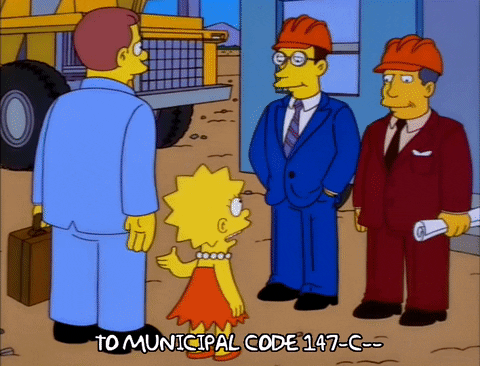
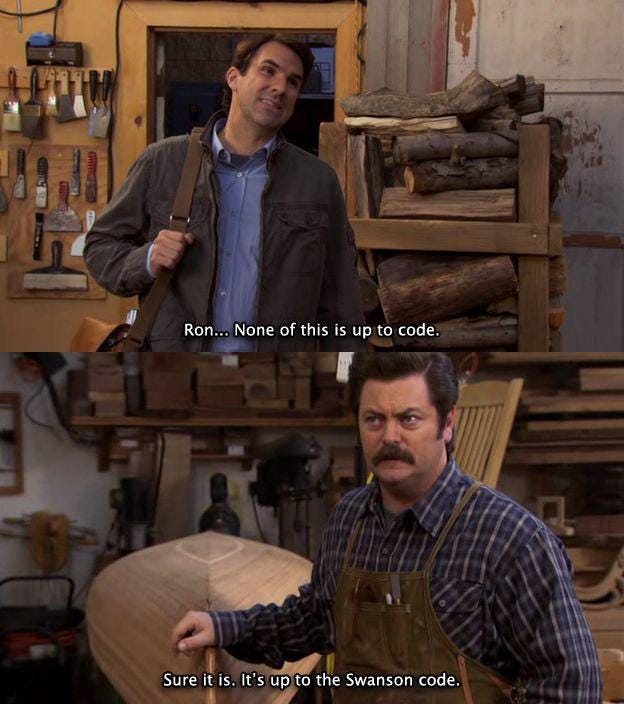
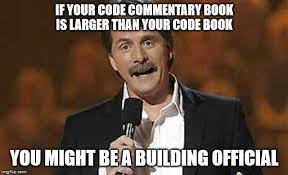
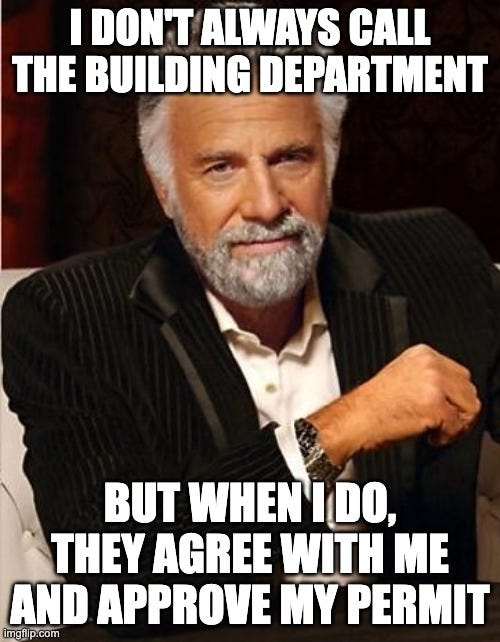
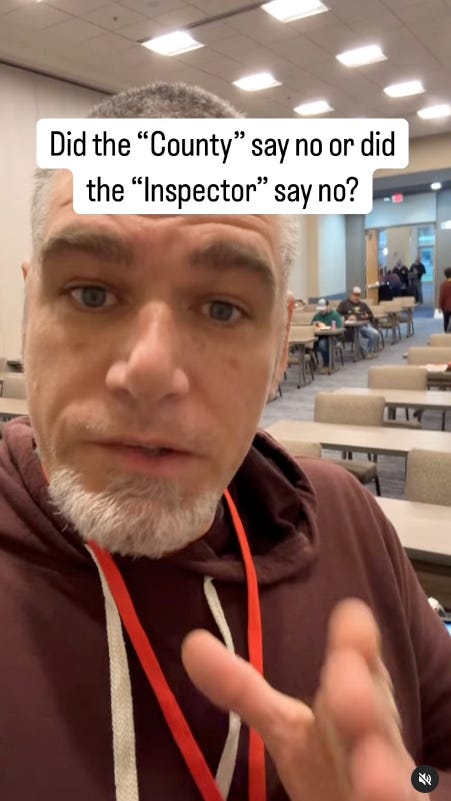


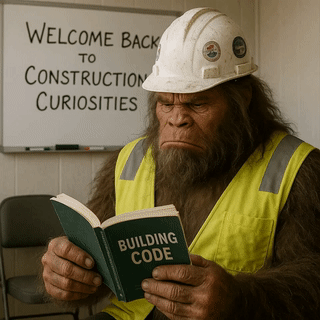
Would you link to the ICC Building Safety Journal article which describes the 41%? I do not doubt it, rather I wish to read it myself.